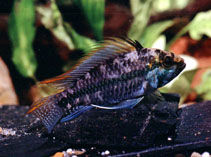
|
Apistogramma luelingi Kullander, 1976 |

|
|
photo by
Hoffmann, P. and M. Hoffmann |
| Family: | Cichlidae (Cichlids), subfamily: Geophaginae | |||
| Max. size: | 3.3 cm SL (male/unsexed); 2.87 cm SL (female) | |||
| Environment: | benthopelagic; freshwater | |||
| Distribution: | South America: Amazon River basin, in the Madre de Dios and Mamoré River basins. | |||
| Diagnosis: | Dorsal spines (total): 15-16; Dorsal soft rays (total): 5-6; Anal spines: 3-4; Anal soft rays: 5-6. This species is moderately elongate (depth 33.1-37.6%, head length 33.4-37.8% of SL); D XV-XVI,5-6; A III,5.i or IV,5-6 (usually 4 spines); gill rakers 1-2; lateral line rudimentary; a longitudinal dark lateral band, 2 (or 3) series of spots longitudinally on abdominal side, no midventral stripe; dorsal and caudal fin not modified in males up 2.6 cm with last dorsal spine length 11.7-15.5% of SL (Ref. 86503). | |||
| Biology: | Eggs are deposited on the ceiling of caves (Ref. 47893). | |||
| IUCN Red List Status: | Least Concern (LC); Date assessed: 25 April 2014 Ref. (130435) | |||
| Threat to humans: | harmless | |||